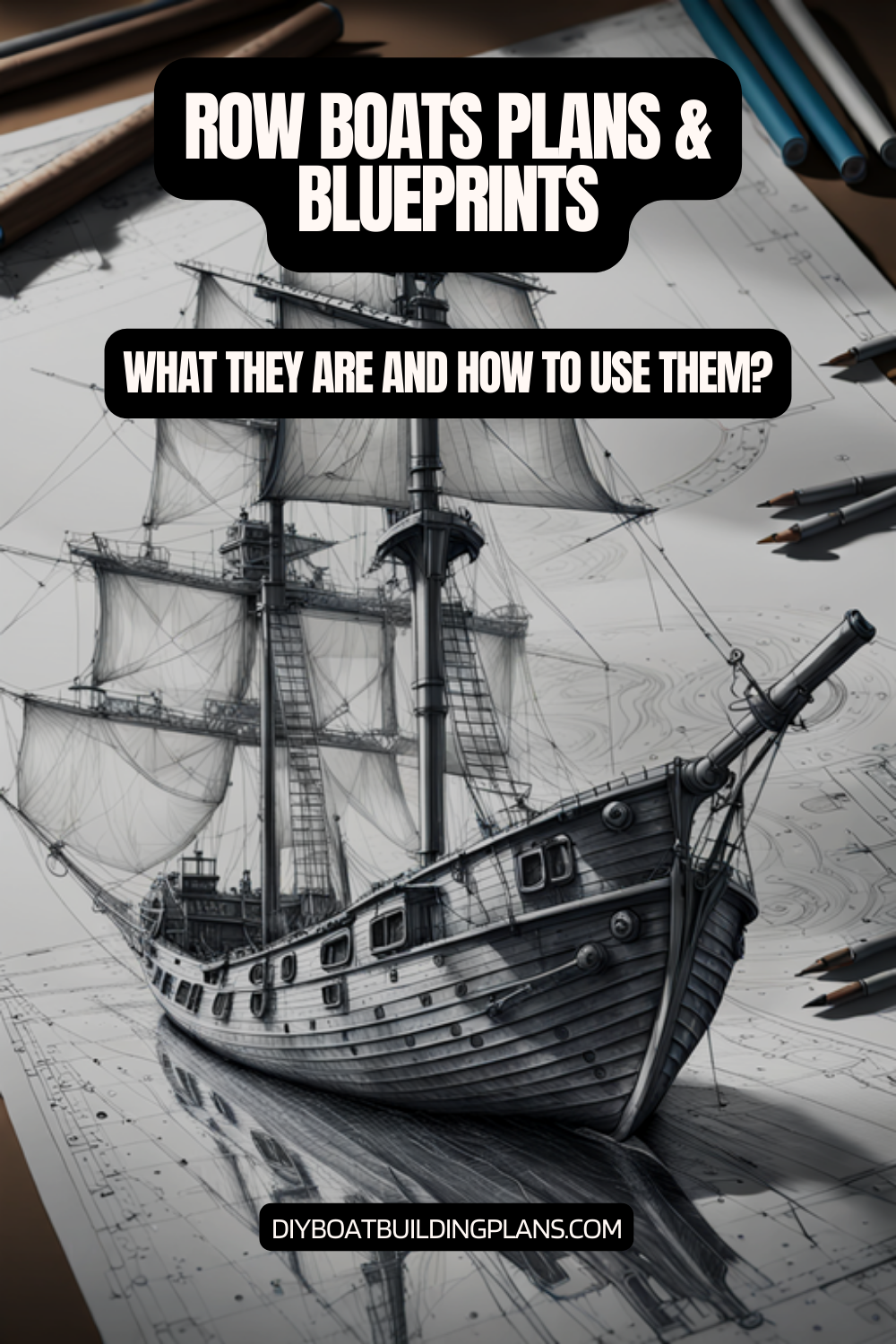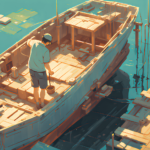Ever thought about turning marine plywood into your own watercraft? DIY Row Boat Plans & Blueprints let you build your dream wooden rowboat at home.
Building your own boat is more than a hobby. It’s a creative journey. You can make a boat for fishing or for camping trips.
Magazines like “Popular Mechanics” and “Popular Science” offer free DIY plans. These plans range from small boats to big fishing boats. There’s a plan for every water lover.
Key Takeaways – Row Boat Plans & Blueprints
- Free row boat plans available in popular magazines
- Designs suitable for multiple activities
- Marine plywood construction techniques
- Lightweight and transportable boat options
- Versatile plans for rowing, sailing, and fishing

Introduction to DIY Row Boat Building
Building your own rowboat is a fun journey that mixes creativity, skill, and love for the sea. Small craft DIY guides help you make your own watercraft that shows off your style and skill.
Starting a rowboat project has rewards that store-bought boats can’t offer. DIY boat building lets you customize, save money, and feel a huge sense of pride.
Benefits of Building Your Own Row Boat
- Full customization of design and features
- Significant cost savings compared to purchasing
- Deep personal satisfaction from creating something functional
- Enhanced understanding of boat construction
- Potential for developing new woodworking skills
Essential Tools and Materials Needed
To build a rowboat, you need to prepare well and have the right tools. It’s important to get quality tools for precision and durability.
| Tool Category | Recommended Tools | Estimated Cost |
|---|---|---|
| Cutting Tools | Table saw, Jig saw, Hand saw | $200-$500 |
| Measuring Tools | Measuring tape, Carpenter’s square, Level | $50-$100 |
| Finishing Tools | Sandpaper, Electric sander, Clamps | $100-$250 |
“Building a boat is not just about following rowboat design schematics, it’s about creating a personal masterpiece that connects you with maritime traditions.” – Traditional Boat Builder
The first step in building your rowboat is choosing the right materials. Marine-grade plywood, epoxy resin, and quality hardware are key for a strong and reliable boat.
Choosing the Right Blueprints
Choosing the right amateur boatbuilding plans is key in your journey. With over 500 boat plans out there, picking the right one is important. You need to think about several factors.
- Skill level compatibility
- Intended boat usage
- Available workshop tools
- Budget constraints
- Construction materials
Factors to Consider in Boat Plan Selection
Your skills are important when picking plans. Beginners should look for simple designs. Complex plans can be too much for new builders.
“The right boat plan is like a roadmap to your maritime adventure – choose wisely!” – Experienced Boat Builder
Popular Row Boat Designs
There are many row boat designs for different needs. Here are a few:
The Storer Rowboat is a great choice for beginners. It’s based on the Goat Island Skiff and is fast and safe. It’s perfect for one person, with room for a few extra.
Online sites like Boat Plans Online and Glen-L Marine have lots of plans. Take your time to look and compare to find the best one for you.
Unlock the secrets to building your dream boat with MyBoatPlans! With detailed plans for over 518 boats and expert video tutorials, you’ll have everything you need to create your perfect vessel. Click here to begin your journey!
Step-by-Step Guide to Building Your Row Boat
Building a row boat is a fun journey that mixes skill, precision, and love. It needs careful planning and focus on details. This guide will help you through the key steps of making your own boat, using trusted rowboat construction manuals.

Before starting, get the right materials and set up a neat workspace. The cost for materials is about $300. You’ll need plywood, lumber, and other building supplies.
Workspace Preparation
- Choose a well-ventilated area with stable work surface
- Gather necessary tools like power drill, saber saw, and sanders
- Protect your work area with drop cloths
- Organize tools and materials for easy access
Wood Cutting and Shaping Techniques
When working with boat carpentry blueprints, precision is key. The wood-cutting process needs careful measurement and a smart approach.
| Material | Recommended Type | Thickness |
|---|---|---|
| Plywood | Marine-grade exterior | 1/4″ to 3/8″ |
| Lumber | Douglas Fir | 1″ x 6″ |
Assembly Techniques
The stitch-and-glue method is a favorite among DIY boat builders. It involves:
- Cutting panels according to rowboat construction manuals
- Stitching panels together using electrical fence wire
- Applying epoxy to seal and strengthen joints
- Removing stitches after epoxy cures
“Patience and precision are your best tools in boat building.” – Traditional Boat Builder’s Wisdom
Most row boat projects take 60-90 total hours to complete. This includes preparation, assembly, and finishing. Remember, each boat is special, and your hard work will show in the details.
Navigating Safety and Regulations
Safety is key in building a wooden rowboat. DIY maritime woodworking needs focus on safety and following the law. Knowing the important safety steps can make your rowing journey safe and enjoyable.
Essential Safety Gear for Row Boaters
Starting your wooden rowboat journey means you need the right safety gear. Building a rowboat is more than just creating a boat. It’s about ensuring a safe time on the water.
- Personal Flotation Devices (Life Jackets)
- Waterproof signaling devices
- Oar locks and backup oars
- Bilge pump
- Emergency repair kit
Understanding Local Boating Regulations
Every waterway has its own rules for DIY maritime woodworking. Local laws often require certain safety measures for homemade boats.
| Regulation Category | Typical Requirements |
|---|---|
| Registration | Boat length and motor specifications |
| Safety Equipment | Life jackets, fire extinguishers |
| Operating Rules | Speed limits, restricted areas |
“Safety doesn’t happen by accident—it’s a deliberate choice in wooden rowboat construction.”
Before starting your DIY project, check the local boating laws. Knowing the rules protects both you and your boat.
Maintenance Tips for Your Row Boat
Keeping your homemade boat in top shape is key. Wooden rowboats need regular care to last long and perform well. This care ensures your boat stays safe and fun to use.
Essential Maintenance Checklist
There are important tasks to keep your rowboat in good condition:
- Weekly cleaning of wooden surfaces (1-2 hours)
- Monthly surface polishing (2-3 hours)
- Inspect for damage or wear
- Check and reapply protective coatings
Addressing Common Repair Challenges
Wooden boats face certain issues that need quick action. Knowing your rowboat’s design helps spot problems early:
- Crack and Split Prevention: Use marine-grade sealants to protect wood
- Rot Mitigation: Apply protective varnishes regularly
- UV Protection: Use specialized marine paints
“Regular maintenance is the key to extending your boat’s life and ensuring safety on the water.”
Professional Maintenance Insights
For big repairs or special care, get help from pros. Over 500 boat plans show why proper care is vital. Winterizing your boat and using marine-grade materials can make it last longer and perform better.
Customizing Your Row Boat
Turning a basic row boat into a unique watercraft is exciting for DIY fans. It’s not just about building a boat. It’s about making a vessel that shows your style and meets your needs.

Customizing your row boat means making it look and work better. You can do this in several ways:
Download over 500 Boat Plans. Click on the link below.
-->Click Here<--
- Custom Paint Schemes
- Unique color combinations
- Marine-grade exterior paints
- Decorative striping techniques
- Functional Upgrades
- Fishing rod holders
- Integrated storage compartments
- Adjustable seating configurations
Adding Personal Touches
Your row boat shows your personality with custom touches. Think about adding hand-carved wooden details, personalized nameplates, or special oar designs. These show off your skills.
“A customized boat isn’t just a vessel—it’s a reflection of the builder’s creativity and passion.”
Upgrading Features for Better Performance
Improving your row boat’s performance can make a big difference. You can make it better by adjusting oarlock positions, adding lightweight materials, or installing special rowing seats.
For those who love traditional rowboat building, these changes are a chance to mix creativity with practicality. This way, your small craft will stand out as truly unique.
Popular Wood Types for Row Boats
Choosing the right wood is key when making amateur boat plans. The wood you pick affects your boat’s performance, durability, and quality.
Wooden boats have a long history of craftsmanship. Each wood type has its own special qualities for building boats. Picking the right wood can turn a good boat into a great one.
Pros and Cons of Different Woods
- Marine Plywood
- Pros: Very water-resistant, strong, versatile
- Cons: More expensive, lacks natural beauty
- Cedar
- Pros: Light, naturally resists rot, has beautiful grain
- Cons: Softer, needs careful handling
- Oak
- Pros: Very durable, strong structure
- Cons: Heavy, hard to work with
Sustainable Wood Options
Today, boat builders are choosing eco-friendly woods. Sustainable wood options include:
- Reclaimed timber from certified forests
- Locally harvested wood with good management
- Engineered wood with low environmental impact
“The heart of a great boat lies not just in its design, but in the careful selection of its fundamental material.” – Traditional Boat Building Wisdom
| Wood Type | Weight | Water Resistance | Cost |
|---|---|---|---|
| Marine Plywood | Medium | Excellent | High |
| Cedar | Light | Good | Medium |
| Oak | Heavy | Fair | Low |
When making your boat plans, think about what your project needs. Each wood type has its own benefits that can improve your boat plans.
Troubleshooting Common Building Issues
Building a row boat with DIY maritime woodworking has its own set of challenges. Knowing what might go wrong can save you time and money. Rowboat construction manuals often point out key areas where builders might face problems.
When you’re building a row boat, you might run into a few common issues. These need careful attention and smart problem-solving.
Identifying Mistakes Early
Spotting problems early is key in DIY boat building. Woodworkers suggest checking these areas:
- Check wood alignment before final joining
- Verify precise measurements multiple times
- Inspect wood quality for structural integrity
- Examine joint connections carefully
Common Construction Solutions
Fixing building challenges needs specific strategies for row boat construction:
| Problem | Solution |
|---|---|
| Misaligned Panels | Re-cut panels or use strategic reinforcement techniques |
| Improper Sealing | Apply marine-grade epoxy with recommended techniques |
| Shape Inconsistencies | Adjust boat lines during early construction stages |
“Precision in boat building is not about perfection, but about understanding and correcting problems before they get big.” – Boat Building Expert
For DIY maritime woodworking fans, patience and careful attention are the most valuable tools in row boat building.

Resources for DIY Row Boat Enthuisiasts
Starting a wooden rowboat project needs good resources. With 719 DIY plans online, you have lots to learn. Websites like Boat design.net and In the boatshed offer great blueprints and tips.
Books are also key for learning boatbuilding. “Boatbuilding for Beginners” and “Devlin’s Boatbuilding” are top picks. They cover the basics and advanced techniques, making complex tasks easier to grasp.
Recommended Books and Guides
Online forums are great for getting help. The WoodenBoat Forum and Boat Design forums are full of experts. Here, you can share your projects, get advice, and find new designs.
Online Communities and Forums
When building a wooden rowboat, look at many sources. Free and paid plans from designers like Robert Dillon are available. Always check plans carefully before starting to ensure your project goes smoothly.
FAQ – Row Boat Plans & Blueprints
What are the best free row boat plans available?
You can find free row boat plans in magazines like Popular Mechanics and Popular Science. Designs include Handy Andy, Junior, and Jolly Roger. There are also plans for folding boats and yacht dinghies.
What tools and materials do I need to build a row boat?
You’ll need saws, drills, sandpaper, and measuring tools. Materials include marine plywood, epoxy resin, and fiberglass cloth. The Storer Rowboat uses marine plywood and basic tools.
How do I choose the right row boat plan for my needs?
Think about what you’ll use the boat for and how many people it needs to hold. Dories, skiffs, and prams are popular choices. The Storer Rowboat is fast and can carry one person with room for another.
What safety precautions should I take when building and using a row boat?
Safety is key. Make sure you have life jackets, oars, and signaling devices. Many designs have safety features like buoyancy chambers. Always follow local boating laws.
What are the best wood types for row boat construction?
Good woods are marine plywood, cedar, oak, and pine. Marine plywood is strong and water-resistant. Cedar is lightweight and rot-resistant. Oak is durable. Choose sustainable woods or reclaimed timber.
How do I maintain my DIY row boat?
Clean it regularly and check for damage. Reapply protective coatings as needed. Use marine-grade epoxy or fiberglass for small repairs. Keep plywood boats sealed to prevent rot.
Can I customize my row boat?
Yes! You can add custom paint, fishing rod holders, and storage. The Storer Rowboat has a wide middle seat and adjustable rowlocks.
Where can I find resources and guidance for building a row boat?
Check out books like “Boat Builder’s Handbook” and online guides. Websites and communities offer free plans and advice. Guides for specific boats, like the Storer Rowboat, provide detailed instructions.



